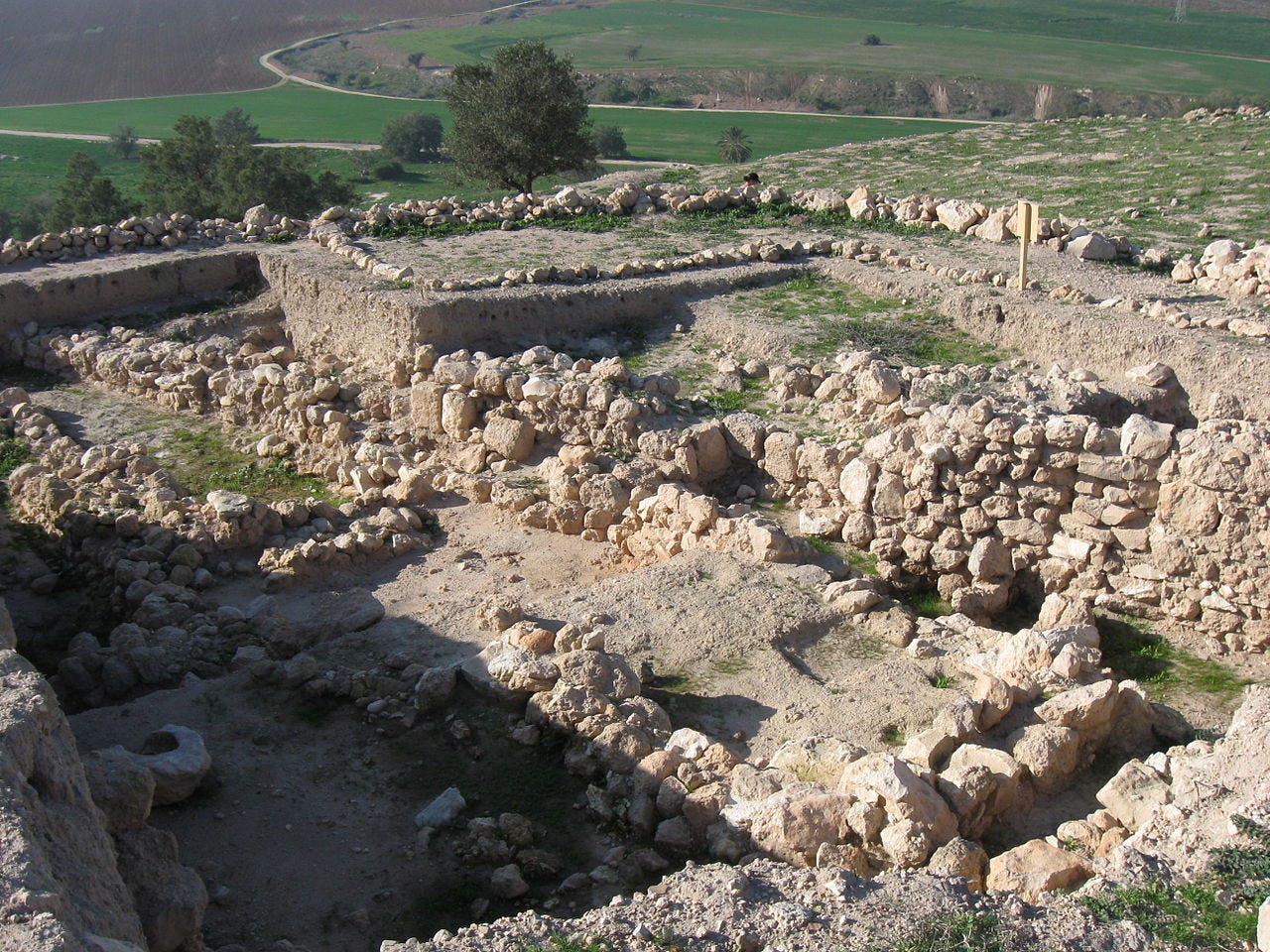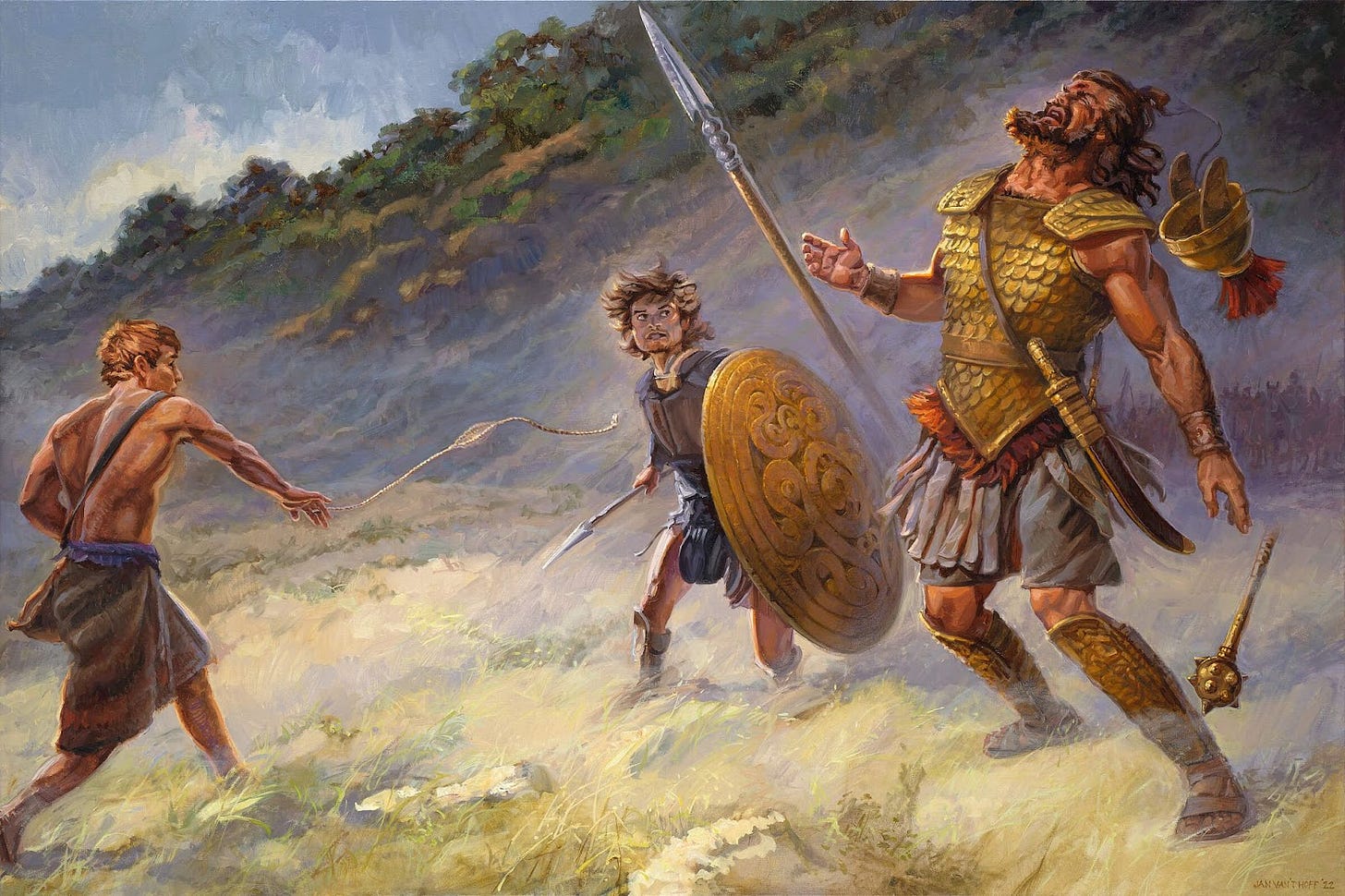Let’s start with a question: “Where is Gath, and are there any names of Goliath found at the location?” From the El-Amarna letters we learn of a city in Canaan under the name Gimti/Gintu ruled by two kings named Shuwardata and ‘Abdi-Ashtarti.1 This name Gintu is heavily associated with the term “Gath” and other scholars connect this “Gintu” with the site of Tell es-Safi.2 The city has been excavated to uncover evidence of a siege and massive destruction of the site around the 9th century BCE coinciding with the biblical capture by Hazael of Aram-Damascus.3
During these excavations a potsherd was discovered dated prior to this destruction around the time of David inscribed with two names ‘LWT and WLT, extremely close and etymologically related to the Hebrew GLYT. It’s very likely this name is related to the name “Alyattes” attested to by the well known Lydian king.4 Carian inscriptions, geographically close to the Lydian territory, also attests to a similar name that operates as an intermediary between the previous Alyattes and Goliath in the form of “Uliat”.5 If these two terms are related through some ancestral connection then the original meaning of Goliath’s name might mean “Lion-man”, a sort of warrior-beast in an Indo-European mythological context.6
The actual name of Tell es-Safi has interesting provenance. The earliest usage of the name comes from the 6th century Madaba Map where it is listed as “Saphitha”7 We aren’t really sure what was happening after it’s previous destruction up until the usage of this name Saphitha in the Byzantine era, but it’s clearly some kind of Greek name that was placed on top of an already earlier name, something like “Saphith”, or “Saphi”. Obvious is to connect this name with the biblical “Saph”, the giant descendant of Rapha who was killed by Sibbecai the Hushathite at the battle of Gob (II Samuel 21:18). In I Chronicles 20:4 this same figure is called “Sippai”, giving us an early deviation from the name within the Torah itself! Sippai, or Saph, most likely becomes the location “Saphitha”.
Stylistic similarities between the narrative formulae of David and Goliath’s battle can be found in sources like the Iliad and other Homeric epics, rather than within the near east. Quite a good reason for this is found in unraveling the origins of the Philistines, but saving that discussion for a later section there is indication the Philistines emerged from a pseudo-Greek identity. Goliath and other Philistines having Greek, or even the previously mentioned Anatolian elements is not at all surprising.8
There is a major parallel that is impossible to ignore between the story of David and Goliath compared to that of the Iliad, written circa 760–710 BCE, where the youth Nestor fights and conquers the giant Ereuthalion.910 Both Giants wield special weapons such as Ereuthalion’s iron club, and Goliath's massive bronze spear. Additionally, they are both clad in armor ready to challenge all the warriors in the opposing army to a one on one battle. In both examples the experienced warriors become afraid, with the challenge being accepted by a youngest of a family - Nester being the twelfth son of Neleus, while David is the seventh (or eight) son of Jesse.
Even after accepting the challenge, Nestor’s father tells the boy he is too young, and inexperienced, the same as we soo of David’s patron Saul. In the end, both heroes receive divine aid and the giant is left sprawled out on the battlefield. Both warriors, while on foot, then take something from the enemy, Nestor taking a chariot and David taking the sword of Goliath. The opposing army flees, the victors give chase and vanquish them, and finally return with their bodies while the boy-hero is acclaimed by the people.11
While some might object to making this comparison, it’s very obvious the Greeks were stealing the story of David to form their own mythology and showing how later civilizations - who by nature of not even having a writing system until after the ancient Israelites who had already begun to formalize their writing systems given they invented the concept of alphabet writing - would have taken this story for their own good. This only strengthens the powerful impact that the story of David had on near eastern cultures, placing him among an ancient Greek cultural milieu that would have well understood his story.
One difficulty is translation of the line איש הביניים, "man of the in-between" from I Samuel 17 which seemingly has no other correlations in Hebrew literature. In Greek there is a similar term "man of the metaikhmion (μεταίχμιον)", i.e., the space between two opposite army camps where champion combat would take place.12 This makes sense to call Goliath a man of the metaikhmion if he was the champion meant to battle David.
Turning attention to a more minor detail in the story, the actual armor described in I Samuel 17 is quite typical of Greek armor from the six century BCE. Other scholars argue the description is a trustworthy reflection of the armaments that a Philistine warrior would have worn in the tenth century BCE.13 Whatever the case it’s very likely this armor style is Philistine in character, regardless of connections to Greece given the Philistines own “Greek” ancestry.
One interesting interpretation of the line comes from the famed Hasidic Rebbe Nachman of Breslov who says “However, opposing [the Brow of Ratzon] (the level just below “God’s crown) is the Serpent’s Brow, which is the root of determinism. For everything has its root, and the root of determinism is MeTZaCh haNaChaSh (the Serpent’s Brow). This is alluded to in what was said of Goliath: “[He had] MiTZChat NeChoShet (greaves of copper) on his legs” (1 Samuel 17:6)—i.e., the aforementioned concept of the Serpent’s Brow. Goliath was a heretic. He wanted to demonstrate that all causality is dictated by nature, God forbid, this being the concept of the Serpent’s Brow.”14 Quite brilliantly, what Reb Nachman does here is turn these copper greaves into a wider metaphor for allegiance to a sort of deterministic heathenry, often seen today in those who believe in a material inevitable causality that cannot be affected through our own free-will granted by Hashem.
While Goliath and the four brothers are prototypical Middonim, descended from the Rephaim, they are not an identification for the Rephaim and merely ‘giants’ that descend from them like many of the other pseudo-Rephaim groups of giants. After this long diversion, let us now turn our attention to the Rephaim.
Naʼaman, Nadav (2005). Canaan in the Second Millennium B.C.E. Eisenbrauns. p. 174
Maeir, Aren M.; Chadwick, Jeffrey R.; Dagan, Amit; Hitchcock, Louise A.; Katz, Jill; Shai, Itzhaq; Uziel, Joe (2019). "The Late Bronze Age at Tell es-Safi/Gath and the site's role in Southwestern Canaan". In Aren M. Maeir; Itzhaq Shai; Chris McKinny (eds.). The Late Bronze and Early Iron Ages of Southern Canaan. De Gruyter. pp. 1–18.
Namdar, Dvory; Zukerman, Alexander; Maeir, Aren M.; Katz, Jill Citron; Cabanes, Dan; Trueman, Clive; Shahack-Gross, Ruth; Weiner, Steve (2011). "The 9th century BCE destruction layer at Tell es-Safi/Gath, Israel: integrating macro- and microarchaeology". Journal of Archaeological Science. 38 (12): 3471–3482.
Maeir, A.M., Wimmer, S.J., Zukerman, A., and Demsky, A. (2008). "A Late Iron Age I/Early Iron Age II Old Canaanite Inscription from Tell eṣ-Ṣâfī/Gath, Israel: Palaeography, Dating, and Historical-Cultural Significance". Bulletin of the American Schools of Oriental Research.
Vernet Pons, M. (2012). "The etymology of Goliath in the light of Carian Wljat/Wliat: a new proposal". Kadmos, 51, 143–164.
Woodard, Roger D. (2022), "On Goliath, Alyattes, Indo-European Wolves, and Lydian Lions: A Reexamination of 1 Sam 17:1–11, 32–40" (PDF), in Rollston, Christopher (ed.), Biblical and Ancient Near Eastern Studies in Honor of P. Kyle McCarter Jr. (Ancient Near East Monographs), SBL Press, pp. 239–254
Kallai-Kleinmann, Z. (1958). "The Town Lists of Judah, Simeon, Benjamin and Dan". Vetus Testamentum. Leiden: Brill. 8 (2): p. 155.
Azzan Yadin (2004). "Goliath's Armor and the Israelite Collective Memory" (PDF). Vetus Testamentum. LIV (3): 373–95.
Finkelstein & Silberman 2007, pp. 198–199.
Israel Finkelstein. "The Philistines in the Bible: A Late Monarchic Perspective". Journal for the Study of the Old Testament. 27 (131): 67.
Zorn, Jeffrey R. (2010). "Reconsidering Goliath: An Iron Age I Philistine Chariot Warrior". Bulletin of the American Schools of Oriental Research. 360: 1–22
Likutei Moharan, Part II 4:7







This is very interesting.